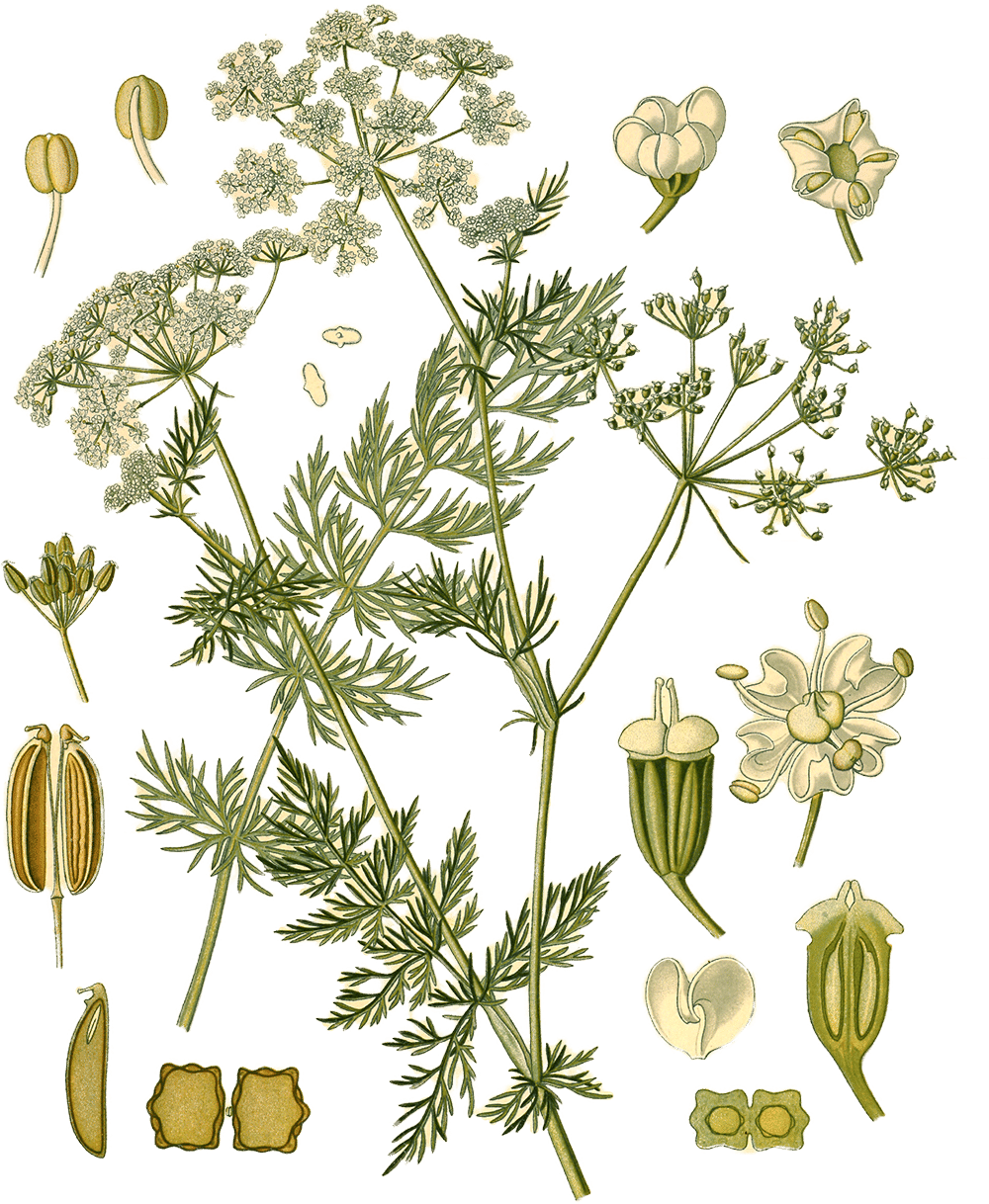Caraway
The seed-like fruits of an Eurasian herb, also known as caraway (seeds).
English: caraway · Hungarian: fűszerkömény · Arabic: كراويا · Chinese: 葛縷子
Overview
| item | caraway |
|---|---|
| taxon | Carum carvi L. |
| family | Apiaceae |
| regions | Northern Europe, Middle Europe, Southwestern Europe, Southeastern Europe, Eastern Europe, Siberia, Russian Far East, Middle Asia, Caucasus, Western Asia, China, Mongolia, Indian Subcontinent |
| continents | Europe, Asia-Temperate, Asia-Tropical |
| part | fruit |
| cultivation | Denmark; Lebanon; The Netherlands; Poland |
| botanical_database | POWO |
CARAWAY is a culinary spice, cultivated for its fruit. It is yielded from the plant Carum carvi L., a perennial in the Apiaceae family, growing in temperate biome, with a native range of Temp. Eurasia.1
It is used primarily in breads, sausages, cheese; carminative. Its aroma is described as warm, sweet, anise-like, with a heat index of 1.2
See more in ( Citation: POWO, 2024 POWO (2024). Plants of the world online. Facilitated by the Royal Botanic Gardens, Kew. Retrieved from http://www.plantsoftheworldonline.org/ ; Citation: Petruzzello, 2021 Petruzzello, M. (2021). List of herbs and spices. Retrieved from https://www.britannica.com/topic/list-of-herbs-and-spices-2024392 ; Citation: Wyk, 2014 Wyk, B. (2014). Culinary herbs and spices of the world. University of Chicago Press, joint publication with the Royal Botanic Gardens, Kew. ; Citation: Dalby, 2000 Dalby, A. (2000). Dangerous tastes: the story of spices. University of California Press. ; Citation: Hill, 2004 Hill, T. (2004). The contemporary encyclopedia of herbs and spices: Seasonings for the global kitchen. J. Wiley. ; Citation: Anderson, 2023 Anderson, I. (2023). The history and natural history of spices: the 5000-year search for flavour. The History Press. )
Illustration of Carum carvi from Köhler’s Medizinal-Pflanzen ( Citation: 1887 Köhler, H. (1887). Köhler’s Medizinal-Pflanzen in naturgetreuen Abbildungen mit kurz erläuterndem Texte: Atlas zur Pharmacopoea germanica, austriaca, belgica, danica, helvetica, hungarica, rossica, suecica, Neerlandica, British pharmacopoeia, zum Codex medicamentarius, sowie zur Pharmacopoeia of the United States of America. Franz Eugen Köhler. Retrieved from https://www.biodiversitylibrary.org/bibliography/623 ) II 91.
Distribution
Native and introduced habitats of Carum carvi3
Native areas: Denmark, Finland, Norway, Sweden, Austria, Belgium, Czechoslovakia, Germany, Hungary, Netherlands, Poland, Switzerland, France, Spain, Albania, Bulgaria, Italy, Romania, Yugoslavia, Belarus, Baltic States, Krym, Central European Rus, East European Russia, North European Russi, South European Russi, Northwest European R, Ukraine, Altay, Buryatiya, Chita, Irkutsk, Krasnoyarsk, Tuva, West Siberia, Yakutskiya, Amur, Kamchatka, Khabarovsk, Kuril Is., Primorye, Sakhalin, Kazakhstan, Kirgizstan, Turkmenistan, Tadzhikistan, Uzbekistan, North Caucasus, Transcaucasus, Afghanistan, Iran, Iraq, Turkey, China South-Central, Inner Mongolia, Manchuria, China North-Central, Qinghai, Tibet, Xinjiang, Mongolia, Bangladesh, East Himalaya, India, Nepal, Pakistan, West Himalaya
Introduced areas: Føroyar, Great Britain, Iceland, Ireland, Algeria, Libya, Morocco, Tunisia, Cyprus, Greenland, Nunavut, Alberta, British Columbia, Manitoba, Saskatchewan, Labrador, New Brunswick, Newfoundland, Nova Scotia, Ontario, Prince Edward I., Québec, Colorado, Idaho, Montana, Oregon, Washington, Wyoming, Illinois, Iowa, Minnesota, Missouri, North Dakota, South Dakota, Wisconsin, Connecticut, Indiana, Maine, Massachusetts, Michigan, New Hampshire, New Jersey, New York, Ohio, Pennsylvania, Rhode I., Vermont, West Virginia, Utah, New Mexico, Kentucky, Louisiana, Maryland, North Carolina, Virginia, District of Columbia, South Georgia
Bibliography
- Anderson (2023)
- Anderson, I. (2023). The history and natural history of spices: the 5000-year search for flavour. The History Press.
- Dalby (2000)
- Dalby, A. (2000). Dangerous tastes: the story of spices. University of California Press.
- Hill (2004)
- Hill, T. (2004). The contemporary encyclopedia of herbs and spices: Seasonings for the global kitchen. J. Wiley.
- Köhler (1887)
- Köhler, H. (1887). Köhler’s Medizinal-Pflanzen in naturgetreuen Abbildungen mit kurz erläuterndem Texte: Atlas zur Pharmacopoea germanica, austriaca, belgica, danica, helvetica, hungarica, rossica, suecica, Neerlandica, British pharmacopoeia, zum Codex medicamentarius, sowie zur Pharmacopoeia of the United States of America. Franz Eugen Köhler. Retrieved from https://www.biodiversitylibrary.org/bibliography/623
- Petruzzello (2021)
- Petruzzello, M. (2021). List of herbs and spices. Retrieved from https://www.britannica.com/topic/list-of-herbs-and-spices-2024392
- POWO (2024)
- POWO (2024). Plants of the world online. Facilitated by the Royal Botanic Gardens, Kew. Retrieved from http://www.plantsoftheworldonline.org/
- Wyk (2014)
- Wyk, B. (2014). Culinary herbs and spices of the world. University of Chicago Press, joint publication with the Royal Botanic Gardens, Kew.
Medicinal Spices Exhibit. (2002). UCLA Biomedical Library: History & Special Collections. https://unitproj.library.ucla.edu/biomed/spice/index.cfm?spicefilename=taste.txt&itemsuppress=yes&displayswitch=0 ↩︎
